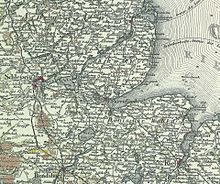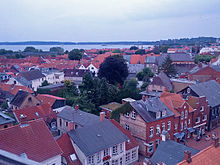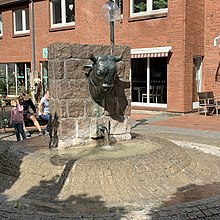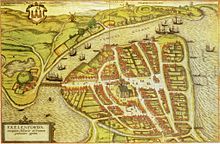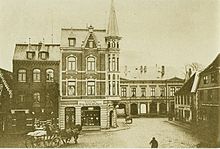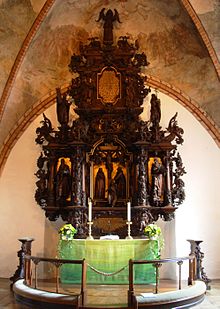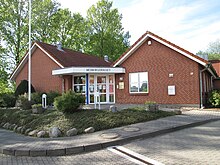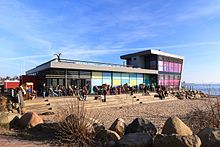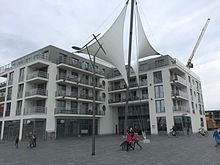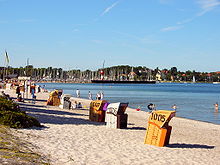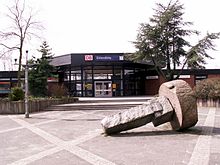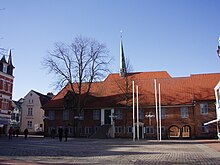Eckernförde
| coat of arms | Germany map | |
|---|---|---|

|
Coordinates: 54 ° 28 ' N , 9 ° 50' E |
|
| Basic data | ||
| State : | Schleswig-Holstein | |
| Circle : | Rendsburg-Eckernförde | |
| Height : | 3 m above sea level NHN | |
| Area : | 21.29 km 2 | |
| Residents: | 21,728 (Dec. 31, 2019) | |
| Population density : | 1021 inhabitants per km 2 | |
| Postal code : | 24340 | |
| Area code : | 04351 | |
| License plate : | RD, ECK | |
| Community key : | 01 0 58 043 | |
| LOCODE : | DE ECK | |
City administration address : |
Rathausmarkt 4–6 24340 Eckernförde |
|
| Website : | ||
| Mayor : | Jörg Sibbel ( CDU ) | |
| Location of the city of Eckernförde in the Rendsburg-Eckernförde district | ||
Eckernförde is a 700 year old port city in the former Duchy of Schleswig . For a good hundred years (1867–1970) it was the county seat of the Eckernförde district .
Names
| language | designation |
|---|---|
| Danish | Egernførde |
| Danish (rare) | Ekernførde, Egernfjord |
| Low German | Eckernföör, Eckernför |
| Angel Danish | Nysted, also Ekelførd and Egelføhr |
| Latinized | Ekerenforda, Ekelenforda |
Districts
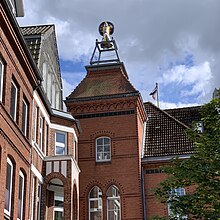
Since Eckernförde has renounced an official division into districts, a precise demarcation between them and the election of local councils, the district names are of historical origin. While the demarcation of the individual districts in the center and north of the city does not cause any major problems today, the exact allocation is difficult today due to the brisk construction activity after the Second World War in the south within and outside the city limits at that time.
At the end of the Second World War, in addition to the city center (old town, which traditionally also includes Preusserstraße and Berliner Straße up to the level crossing):
- Borby in the north , the south of the then Jungmannweg (today: "Am Ort") including the extension road in the former TVA-Nord area of Louisenberg , the traditional Eckernförde-Nord (the areas west and south of Borby, which were before the incorporation Borbys belonged to Eckernförde such as the suburb Steindamm (district name used until the 1960s) and the area between Windebyer Noor and Ostlandstraße) as well as Carlshöhe (or: Karlshöhe ), Schnaap (Borby district until 1934) and the Vogelsang area (belonged to Eckernförde between 1708 and 1934, before that to Borby). For the demarcation between Eckernförde and Borby see article: Borby.
- in the south the traditional Eckernförde-Süd (including Rendsburger Straße as far as Brennofenweg, Kakabellenweg, eastern part of Windebyer Weg), Sandkrug (up to and including Hoheluft and today's Feldstedt, Am Eichberg) and Sophienhöh (the one starting from the intersection of Rendsburger Straße / Domstag / Wulfsteert Development including, inter alia, Bismarckstrasse and later “Rendsburger Lager” and the then remote Weidenstrasse) as Eckernförde districts. Between these parts of the city there were still mostly considerable vacant lots (for example the central part of the cathedral day was still surrounded by agricultural land and the central part of Sehestedter Strasse was still undeveloped, on Brennofenweg there were only a few houses near Rendsburger Strasse, Nettelbeckstrasse did not yet exist). This situation is impressively shown by a vertical aerial photo taken by British aerial reconnaissance on April 9, 1945 Wilhelmsthal has belonged to Eckernförde since the 1930s, and apart from the manor houses, it consisted almost entirely of agricultural land.
At the time of the end of the Second World War, there were still outside Eckernförde:
- in the north: the northern part of Louisenberg and Grasholz (originally part of Eckernförde until 1637). Grass wood (previously part of Gammelby ) was incorporated into the municipality in 1973, the northern part of Louisenberg (and individual houses on Dorotheenstrasse, which until then belonged to Barkelsby ) in 1974.
- in the south Windebyer Mühle (the place was in the area of today's Möhlenkamp, the associated area comprises around ⅔ of today's Diestelkamp-Wulfsteert development), the areas of the Goosefeld district of Marienthal , which today belong to Eckernförde (industrial area Marienthal and Wilhelm-Lehmann- Straße), the area of today's Domsland settlement and the area of today's Broosbyer Koppel (was sometimes referred to as a new district in the 1960s to 1970s and was assigned to the Windebyer Mühle area). The incorporations in the south of the city took place between the early 1960s and the 2000s.
Around 1900 Borby was independent within today's Eckernförde area , the present-day town and districts Sandkrug and Wilhelmstal (then still: " Wilhelmsthal ") belonged to Marienthal , Louisenberg to Hemmelmark , Schnaap to Borby (as an exclave ), Sophienhöh to Eckernförde, Grasswood at Gammelby.
Grass Wood has two districts ( Sophienruh and the southern part of Flint Mountain ), Borby several - these are among others: Borbyhof , dirt road settlement , Borbyer Hagen (today hardly common name for the area in which, among other things, the Kösliner ring and the new Borbyer Friedhof), the exclave `` Schnaap '', the traditional Eckernförde-Nord over two ( Püschenwinkel and Schinnerkuhl . Vorstadt Steindamm and Vogelsang not included), Louisenberg over one ( At the place , also: The place ).
In terms of cadastre, a distinction is still made between the Eckernförde and Borby districts within the town of Eckernförde ; In addition, there are parts of the city and districts within the city limits that continue to belong to other districts, such as grass wood ( Gammelby district ) and the Eckernförde share in Marienthal ( Marienthal district ).
On January 1, 1974, parts of the communities Barkelsby, Gammelby and Goosefeld were incorporated.
location
Eckernförde is located on the Baltic Sea at the end of Eckernförde Bay , halfway from Kiel to Schleswig. The place is partly in Schwansen and partly in the Danish Wohld . The area of the city is today with 2,087 hectares more than twice as large as in 1910, when it was 894 hectares. Neighboring municipalities are the municipalities of Barkelsby , Gammelby , Windeby , Goosefeld and Altenhof (listed from north to south in an anti-clockwise direction) belonging to the Schlei-Ostsee Office (based in Eckernförde ).
Nearby cities (all between 20 and 30 km away from Eckernförde) are: Kappeln , Arnis (the smallest city in Germany), Schleswig , Büdelsdorf ( elevated to a city in 2000 ), Rendsburg and Kiel (also listed from north to south counterclockwise).
The city center is enclosed in the shape of an hourglass by the Baltic Sea in the east and the Windebyer Noor in the west. The city has the largest expansion with over seven kilometers along federal highway 76 in a north-west-south-east direction. The 42.6 m above sea level NN highest point of the city is in the area of the kiln path in the south of Eckernförde. The city has a natural harbor, which is connected to a long sandy beach to the south .
Of the total of 2,087 hectares of community area, 404 hectares are on the Windebyer Noor , just under 17 hectares on the Großer Schnaaper See , almost six hectares on the Kleiner Schnaaper See , almost two hectares on the Upper Eimersee and 290 hectares on a communal portion of the Baltic Sea. If the water of the Goossees were not constantly pumped out so that its water level is 0.7 m below sea level below that of the sea, part of the lake would be on Eckernförde's area. In addition to the lakes, there are some streams in the urban area, including the Lachsenbach (flows through the Upper Eimersee and flows into the Baltic Sea), the Möhlwischbach (flows into the Baltic Sea), the Schnaaper Au (flows through the Großer Schnaaper See and the Kleiner Schnaaper Lake and flows into the Windebyer Noor), the Broosby brook (flows into the Windebyer Noor).
geology
The geology of the Eckernförde area and thus the city of Eckernförde is predominantly shaped by the Vistula Ice Age. In Schleswig-Holstein, the Baltic Sea glacier from the soft ice age divided into a "Holstein Lobus " and a "Eckernförde Lobus". The "Eckernförde Lobus" expanded from today's fishing to today's provost and divided into a northern (" Windebyer Noor tongue " ) in today's Eckernförde area using a contour line of the Eckernförde Bay (which according to some geologists was created before the Ice Age) ") And a southern (" Wittensee - Goossee tongue ") partial ice tongue. The northern tongue formed u. a. the Hüttener -, the southern the Duvenstedter mountains.
Even more than the Ice Age itself, it was the various melting stages of the "Eckernförde Lobus" that are responsible for today's landscape in and directly around Eckernförde. The high morphological diversity within the city limits includes still existing ice-tongue basins ( Goossee- Niederung, Windebyer Noor including adjacent silting areas ), sanded ground moraine landscapes and dead ice forms (Eckernförde-Süd, area of the Schnaaper lakes, Borby, Gallberg etc.), some with muddy depressions such as the Domslandmoor , the Marienthaler Wald or the Wulfsteert-Senke, lateral moraines (especially included in the ground moraine landscape of the southern Eckernförd, where the city has its highest point in the area of the Brennofenweg with 42 meters, as well as on the Windebyer Noor) and low lying (Möhlwischtal, Lachsenbachtal, Koseler Au, etc.) as well as sloping (incisions such as today's Liliencronweg) meltwater channels. Former cliffs or cliffs are located in the Eckernförde urban area both on the Baltic Sea (in the south and in Borby) and on the Windebyer Noor.
The old town of Eckernförde, on the other hand, lies on a spit that was created on a probably boggy subsoil post-glacial over several thousand years by sand washes , the formation of which is likely to be favored by lower water levels in the Baltic Sea. Today this separates the Windebyer Noor from the Baltic Sea. The sand flow coming from the south is currently leading to widening of the city in the area of the outer port; In the 17th century, the whole of today's Jungfernstieg was still a beach and even in the middle of the 19th century, the road that had been laid out in the meantime still bordered the beach in parts.
history
The origin of the city name Eckernförde is not precisely proven and is in dispute. The first part of the name Eckern possibly refers to beechnuts , as red beeches used to form a closed forest area in today's urban area . Hence the squirrel (Danish egern , old Danish ikorni ) in the coat of arms, according to another name interpretation it is the squirrel itself that led to the first part of the name. The second part of the name - förde <vore is derived by some people from the Lower Saxony part of the name -vörde for ford .
However, the Eckernförde historian Jann Markus Witt mentions two possible ways of interpreting the name: either “Förde near Eckernburg” or “Eichhörnchenfurt”. In the early documents, the old Danish name fluctuates and is occasionally formed with -burg ("Ykælænborg" or "Ykernæburgh" = about "squirrel castle").
According to the German place names book "the place name reflects the Entsehung the city under cover of Aselsburg (Ecker castle, squirrels Castle resist). Combined with -furt or Förde , the name thus referred to a settlement near the ford on the squirrel castle . "
The place names Eckernfördes began in the past mainly with the initial letter E, also with the initial letters buch, H, N (see above) and Y (see above).
The exact founding date of the Eckernförde settlement is unknown; when the Danish Union King Erich v. Pomerania burnt down the city in 1416 in the war against the Counts of Holstein , allegedly all documents were lost. The name Ekerenvorde was first mentioned in 1197. At this point the Borby Church was already on the opposite side. At the end of the 12th century, the Danes built a castle at the end of Eckernförde Bay , which was mentioned in 1231 in King Waldemar II's earth book as Ykernæburgh (Squirrel Castle ). This is indicated by the Borby district (Danish Borreby von borg , castle). Around 1210 the construction of the merchant's church, initially single-nave, named after Saint Nicolaus, began. At that time, Eckernförde was part of the Fræzlæt administrative region , which was administered from Eckernförde.
In 1302 Eckernförde was mentioned as a city for the first time without any doubt.
In the course of the Reformation , Eckernförde, like the rest of Schleswig, became Lutheran . In 1574 a radical Reformation Anabaptist congregation had also formed in the city , which appeared publicly against the Lutheran clergy . The community was ultimately driven out of the city by force and was later able to settle in Prussia .
In the 18th century the town experienced its first economic boom as a fishing port and industrial location (for example the Eckernförde faience factory ). Above all, the merchant and factory owner Friedrich Wilhelm Otte was successful and well known.
With the founding of the seaside resort in 1831 in the fishing village of Borby , which was later incorporated , the tourist tradition of Eckernförde began, with fishing remaining an important economic factor long into the 20th century thanks to the well-located harbor . Smokers in particular made the city widely known, although the sprats are still mainly associated with the neighboring city of Kiel to the south .
In 1848 civil war broke out in the Duchy of Schleswig . Eckernförde quickly came under the control of Schleswig-Holstein. On April 5, 1849, Eckernförde was the target of a Danish attempt to land during the Schleswig-Holstein War . This battle near Eckernförde also ushered in the second phase of the Three Years War . The Danish ship of the line Christian VIII and the frigate Gefion were shot at by the rebels' beach batteries , with the ship of the line exploding , the frigate surrendering and being taken over by the Schleswig-Holsteiners. The German public was primarily aware of the Coburg Duke Ernst II as the highest-ranking commanding officer and Eduard Julius Jungmann because of their military achievements. After the defeat of the Schleswig-Holstein rebels in 1850, the entire state was restored under the Danish crown.
With the separation from the Danish monarchy and annexation to Prussia (1864/1866) Eckernförde lost most of its trade. It fell increasingly into the shadow of the rapidly developing naval location Kiel.
In the great storm flood of November 13, 1872 , Eckernförde suffered the most severe damage of all coastal towns in the Baltic Sea due to its location on the bay, which is open far to the northeast. For days, the entire urban area was flooded meters high, 78 houses destroyed, 138 houses damaged and 112 families left homeless.
Eckernförde has been a garrison town and naval base since 1912, as well as the seat of a torpedo testing institute (TVA Eckernförde) with two areas in Eckernförde (TVA North and TVA South) and several branches outside of Eckernförde (see Defense Technical Service 71 ).
The Kapp Putsch in March 1920 led to bloody street battles in Eckernförde between the invading putschists and a "workers' army" made up of around 1,600 Eckernförde and Borbyern.
Nazi era
The brown terror began even before the seizure of power , when two trade unionists were murdered on July 10, 1932 in an attack by the SA and SS on the union building in Borby. During the time of National Socialism , the later Prime Minister of Schleswig-Holstein Helmut Lemke became mayor of Eckernförde as an NSDAP member . On April 5, 1933, numerous social democrats , communists and active “free” TVA trade unionists were arrested in Eckernförde and taken into protective custody for several months . In a second wave of arrests in 1936 resisters from the room Kiel, Rendsburg and were - in Eckernförde - especially prisons or concentration camps spent. A third wave of arrests after the assassination attempt on July 20, 1944 led to the tragic death of Borby's SPD mayor and union secretary Richard Vosgerau, who was re-elected in March 1933. All that is known about the fate of the few Jews living in Eckernförde is that Emmy Massmann, a Jewish woman who survived the Auschwitz and Bergen-Belsen concentration camps , and that Klara Götting, who lived in Eckernförde from 1929 to 1937, followed suit with her husband Arthur Retired from Göttingen and escaped deportation to a concentration camp because of her non-Jewish husband; he was a high school teacher at the Jungmannschule in Eckernförde , designed the Gefion fountain and had refused to part with his wife.
The seaside resort Borby was incorporated into the town of Eckernförde on April 1, 1934 at Lemke's instigation. With the incorporation , the city's population rose from just under 8,000 to over 10,000.
Eckernförde was apparently declared an " Open City " on May 3, 1945 .
post war period
In the post-war period Eckernförde belonged to the British zone of occupation . The military administration set up a DP camp to accommodate so-called displaced persons . It had the administrative number 1206, consisted of three sub-camps and was looked after by a UNRRA team . In 1947 over 2500 DPs lived here. The camps were disbanded in December 1949.
The influx of over 10,000 refugees from the eastern regions of the German Reich into Eckernförde, which was almost spared by bombs, led to a major housing shortage until the 1970s. Camps built for the influx of TVA workers in 1943 with a capacity of at least 6,000 were used as refugee camps and expanded; more camps arose. Between 1935 and 1947 the population almost tripled from 10,000 to 28,000 due to the influx of TVA employees, refugees and those who had been bombed out. In 1945 alone, the population grew from around 16,000 to more than 26,000. In May 1945 it is estimated to have been around 60,000. Nevertheless, in the first post-war years, the city became a "war winner" in some areas; Examples include the relocation and settlement of businesses (including the JP Sauer & Sohn weapons factory ), the founding of the first symphony orchestra for Schleswig-Holstein after the war with its headquarters in Eckernförde (Schleswig-Holstein concert orchestra), the establishment of the riot police in 1951 (1956 relocated to Eutin) as well as the sporting successes of Eckernförder SV. In the last 20 years Eckernförde has changed from a tranquil port city to a tourist center on the Baltic coast.
politics
The council of Eckernförde is usually from 27 volunteer members every five years to be re-elected. By slip and stairway and compensatory seats may lead to an increase in the number of councilors. In the electoral period from 2008 to 2013 there were a total of 34 councilors and from 2018 to 2023 there were even 41. From the middle of the council assembly, the members elect a chairman, the mayor . He chairs the meetings and represents the council assembly vis-à-vis the mayor. The incumbent mayor is Karin Himstedt (CDU).
In addition to the parties represented since the local elections in Schleswig-Holstein in 2018 , the Eckernförde council assembly also belonged to the KPD , BHE , GDP , SHWG, Eckernförde voter association , AVP (through the transfer of an FDP councilor in the mid-1970s), instead of the party , Free voters (through the transfer of a member of the council elected to the CDU in the 2008–2013 election period) and the Citizens' Forum (2013–2018).
Local election 2018
For the municipal elections in Schleswig-Holstein in 2018 for the Eckernförde city parliament, the Eckernförde Citizens' Forum , which won 17.1 percent of the vote in the 2013 elections and thus won five council seats, did not run. With the exception of the SPD , the other parties were able to benefit to a greater or lesser extent from the withdrawal of the Citizens' Forum - Alliance 90 / The Greens gained almost ten percent more votes. Since all 14 direct candidates of the CDU were elected, the number of council seats increased to 41 through 14 overhang and compensatory mandates. The second largest party was the SPD in eight constituencies and the Greens in six.
The strongest party in Eckernförde was again the CDU . It won in Eckernförde - against the national trend - with 34.0 percent three percentage points, after previously incurring losses several times in a row. Compared to the 2008 local elections, this is a loss of 3.7 percent, compared to the 2003 election of 14.8 percent. The CDU won 14 council seats, all directly (2013: 8 seats / 31.0%; 2008: 14 seats / 37.7%; 2003: 15 seats / 48.8%).
Despite losses of 6.5 percent, the Social Democrats were able to maintain second place just ahead of the Greens with 21.7 percent and, thanks to the 14 overhang and compensatory mandates, even increased the number of their council mandates from seven to nine (2013: 7 seats / 28 , 2%; 2008: 9 seats / 26.6%; 2003: 8 seats / 27.6%).
Bündnis 90 / Die Grünen emerged as the big winners of the Eckernförde 2018 council elections in Eckernförde: The Greens almost doubled their 2013 election results. With 19.4 percent of the vote, they now have eight instead of three council members (2013: 3 seats / 9.8 %; 2008: 3 seats / 10.2%; 2003: 2 seats / 9.6%).
The three other parties were also able to generate profits. They are followed by the CDU, the SPD and the Greens of the SSW with 10.2 percent of the vote and four council seats (2013: 2 seats / 7.5%; 2008: 3 seats / 10.0%; 2003: 2 seats / 9, 0%), the FDP with 7.6 percent of the vote and three council seats (2013: 1 seat / 3.8%; 2008: 3 seats / 8.1%; 2003: 1 seat / 5.2%) and Die Linke with 7.0 percent and also three council seats (2013: 1 seat / 2.7%; 2008: 2 seats / 7.5%; 2003: not run). The FDP was able to double its share of the vote, the Left more than doubled.
The proportion of women (16 in total) is 39.0 percent (Left: 66.7%, Greens and SSW each: 50.0%, SPD: 44.4%, CDU: 28.7%, FDP: 0.0% ).
How much the voting share of the individual parties can differ at the level of a municipality is shown by the example of the 14 Eckernförde constituencies: the CDU's share of the vote was between 28.7 and 40.8%, that of the SPD between 17.7 and 26, 1%, that of the Greens between 15.7 and 23.4%, that of the SSW between 5.2 and 15.6%, that of the FDP between 4.9 and 9.5% and that of the left between 4.8 and 9.5%. For comparison: in the district election held at the same time, the CDU received 32.4 (2013: also 32.4), the SPD 21.5 (2013: 33.4), the Greens 18.6 (2013: 33.4) within Eckernförde (constituencies 22 and 23) 2013: 12.6), the SSW 7.8 (2013: 10.0), the FDP 5.8 (2013: 5.1), the Left 5.7 (2013: 4.8), the community of voters in the Rendsburg district -Eckernförde (WGK) 4.1, the AfD 3.8 and The Party 0.5 percent of the vote. WGK, AfD and The Party did not run in 2013.
mayor
In the election of September 24, 2006, Jörg Sibbel , who was then Mayor of Osterrönfeld , who was not a party to the election , won with 65.7 percent of the vote. He took office at the beginning of 2007 and ended an epoch of social democratic mayors that had lasted around 38 years.
Its last predecessors were:
- 1945–1952 Ewald Wendenburg , head of administration (1946–1950 with the title of City Director ), initially independent , then CDU
- 1952–1966 Werner Schmidt , GKG - then non-party - then FDP
- 1966–1969: Hans Wiedemann , independent
- 1969–1987: Kurt Schulz , SPD
- 1987–1998: Klaus Buß , SPD
- 1998–1999: Ingrid Ehlers , SPD (acting)
- 1999–2006: Susanne Jeske-Paasch , SPD
The list of city leaders of Eckernförde includes mayors and other city leaders since the middle of the 16th century.
coat of arms
Blazon : "In gold over three blue corrugated strips, a wide, brick-built blue pinnacle tower with a closed gate, on whose pinnacles a red squirrel runs."
Town twinning
- Macclesfield in England (from 1953 to 2010, friendly relations remain)
- Hässleholm in Sweden (since 1958)
- Tanga (Tanzania) (since 1963)
- Nakskov in Denmark (since 1969)
- Brzeg (Brieg) in Poland (since 1989)
- Bützow in Mecklenburg-Western Pomerania (since 1990)
Culture and sights
Eckernförde has a number of cultural monuments of particular importance that are entered in the monument book . These are various buildings, plus some monuments and parks, such as the park on Borbyer Ufer or the Kurpark. The oldest building registered as a monument is the Borbyer Kirche, the youngest the new technical college building on Lorenz-von-Stein-Ring.
Old town
The old town with its narrow streets and restored fishermen's houses lies between the harbor and the beach . The town hall market as the cultural center of the city has largely been preserved in its structural fabric after the Second World War and offers a historical backdrop for the weekly market and other events. Kieler Strasse became a pedestrian zone. Sights in the old town:
- Sankt Nicolai Church , with an early Baroque altar by the Eckernförde carver Hans Gudewerth the Younger and numerous epitaphs from the Renaissance and Baroque periods
- Old town hall (Eckernförde) from the 15th century, today Museum Eckernförde (see below) with an insight into the town's history
- numerous residential buildings, including
- the so-called knight's castle , business and residential building with a Renaissance gable from the 15th or 16th century
- (on the edge) the round silo from 1931.
- Office building
- Old post
- Schuch store
Churches outside the old town
- Borby Church , Protestant, field stone building from the 12th century, expanded in the 13th century.
- Danish Church Eckernförde , Danish church in southern Schleswig
- Roman Catholic Church of Saints Peter and Paul
- New Apostolic Church
- Evangelical Free Church
Surrounding area
- Manors that are largely owned by old families.
- Windebyer Noor
Museums
- Museum Eckernförde (former local history museum) in the old town hall shows the history of the city and offers as a special feature a model railway system that reproduces the Eckernförde station in 1951, as well as a collection of historical electrical appliances.
- Baltic Sea Info Center on the beach, illustrates the flora and fauna of the Baltic Sea and has numerous seawater aquariums
- Old fish smokehouse Eckernförde
Culinary specialties
- Kakabelle beer: the beer that has been brewed in small quantities for certain occasions (now by the "Ricklinger Landbrauerei") in the late Middle Ages (until 1503 under the name "Quackeltheiß") and in the early modern era was a Eckernförde export hit and became also enjoyed by Danish kings. The import ban on foreign beers (meaning: the kingdom, not the state of Denmark), issued by the Danish King Christian IV in 1622, is said to have primarily aimed to protect the kakabelle beer. Heinrich Rantzau reports how the beer got its name : Eckernförde is also known for its wholesome beer. It is called, following Cardinal Raimund (erg. Peraudi) , Cacabille, because according to his words - with all due respect - it makes pooping pleasant. He had called it cacabelle in Italian; the residents then made cacabille out of it.
- Kieler Sprotte : The smoked fish specialty Kieler Sprotte comes from Eckernförde and got its name only because it received the freight stamp of the Kiel train station when it was shipped in the 19th century. The Kiel sprat is one of the smoked fish products to which the saying “In Eckernför, dor hebbt se't rut, ut Sülver Gold to maken” (in Eckernförde they have got it to make gold out of silver) refers: what is meant is the golden color who have favourited Silver Fish from the Smoking Process.
- Küstennebel: The Küstennebel is an aniseed schnapps produced by the spirits manufacturer Behn since 1985 . The fog sound system statute of the city, which had not been revised for years, resulted in a permanent coastal fog in Eckernförde de jure until May 1984: According to the local statute, this was the case when "the building of the Sauer and Son company was no longer visible from the pier" . The view of this building had long since been blocked by a new building. In addition, it was now owned by the German Armed Forces - the Sauer & Sohn company had moved to another part of the city in the early 1970s.
- Little Feigling : The clear spirit with vodka and fig flavor has also been offered by the spirits manufacturer Behn since 1992.
Regular events
- Easter: Easter bonfire and kite festival on the south beach
- Pentecost: Sprat days
- first weekend in June: Motoküstika
- Mid-June: Eel regatta as the opening regatta of the Kiel Week
- July and August: Music event series on the Rathausmarkt
- first weekend in August: pirate spectacle (1997-2006 under the name "Pirate Days")
- July or August: Eckernförde Beach Festival since 2007 annually with well-known bands and performers such as B. Joe Cocker , Rod Stewart , Ich + Ich , Culcha Candela or Die Fantastischen Vier am Südstrand (2011 no beach festival)
- Beginning of September: International nature film festival GREEN SCREEN
- End of November to Christmas: Christmas market around the St. Nicolai Church
- Wilhelm Lehmann Days , annually in honor of the poet and honorary citizen, organized by the Wilhelm Lehmann Society and the City of Eckernförde's Department of Culture, and since 2009 the Wilhelm Lehmann Prize has been awarded
- Old town festival: about every three years organized by the Eckernförde Old Town Association. Here, in the historic old town (Gudewerdtstrasse, Kattsund, Fischerstrasse), private backyards are made accessible to the public and visitors are presented with historical life in Eckernförde.
languages
Eckernförde is a multilingual city: In addition to the official language High German , colloquial Danish (especially in Sydslesvigdansk , a variant of Imperial Danish ) and Low German (mainly in Schwansener Platt , a minor dialect of Schleswigsch ) are spoken. In the meantime, these languages have also become optional official languages in addition to Standard German through Section 82 b LVwG SH .
Eckernförde's official language was Latin until around 1350, then Low German, and Standard German from 1625; the official language of the state was also Danish for centuries. Historically, the South Jutian language area reached as far as the Eckernförde-Treene-Husum line in the Middle Ages.
While in Eckernförde since 1912, Johann-Hinrich-Fehrs-Gill in particular has taken care of the maintenance and preservation of the Low German language and customs (including theater and costume groups), the Danish minority has a number of facilities to maintain language and customs such as a school ( Jes-Kruse-Skolen ), two kindergartens, a meeting house ( Medborgerhuset ) and a church ( Egernførde danske Kirke ).
The traditional multilingualism meant that place names within the city range from city and district names (e.g. Borby of Danish origin) to the official street names of different linguistic origins; some are mixed forms (the street Klintbarg e.g. from Danish: Klint = steep coast and Plattdt .: Barg = mountain). In addition to the official street names, there are partly unofficial synonym names in the minority languages (e.g. flat German : Peermarkt for horse market , Danish: Langebroegade for Langebrückstraße )
The entrance signs in Eckernförde were replaced at the beginning of 2008 by bilingual place name signs with the Low German place name form Eckernföör .
Pillauer Monument to the Great Elector
The monument to Friedrich Wilhelm (Brandenburg) was designed by the Berlin sculptor Fritz Schaper and inaugurated in Pillau in 1913 . It was supposed to be melted down during World War II. Already brought to Hamburg, it was erected in Eckernförde in 1955. Many refugees and displaced persons came there in the post-war period in Germany and Eckernförde had taken on the sponsorship of Pillau. According to a decision by the city administration, the monument should remain in Eckernförde "until it can return to its old place in peace and freedom". Friedrich Wilhelm does not have a good reputation in the area: after 1648 he was with a Polish regiment in Gottorf Castle . He was not in control of the regiment; it robbed and smashed everything that was left of the Thirty Years' War in Schwansen .
The lower panel bears the inscription:
Sports
There are around 50 sports clubs in Eckernförde. The largest of them is the Eckernförde men's gymnastics club from 1864 (EMTV) with over 2,300 members and 16 branches . The other sports clubs are one- or two-branch clubs. The range of sports on offer ranges from popular ones such as soccer, handball or tennis to various Asian martial arts offered in several clubs. It almost goes without saying that in a city on the coast there are several sports clubs dedicated to various water sports such as fishing, swimming, rowing, sailing, diving or surfing. Danish sports clubs are Eckernförde IF and Egernførde Badminton Club .
Nationally noted successes can be seen above all in the Association of Yacht Teams in Eckernförde from 1906 and the Eckernförde Sailing Club (SCE) - the names Horst Dittrich and Holger Jess should be mentioned in particular. Horst Dittrich's crew was able to win the German championship title and international successes several times in the Folkeboot class (1982, 1998, 1999, 2000 - most recently in the line-up of Horst Dittrich, Knut Nommels, Heinz Schacht), for example the unofficial world championship in this boat class in 1984 , the gold cup , with the boat Mareike (Horst Dittrich, Hartwig Sulkiewicz, Peter Lehr); twice (1986, 2000) this competition was held in Eckernförde. Holger Jess , who is now starting for the Potsdam Yacht Club, has been - since 1999 together with Wolfgang Hunger - German champion several times in the 505 boat class (1995, 1996, 1997, 1998, 1999, 2001, 2002, 2003) and also European champion (2004) and world champion (2001, 2003, 2005). Further championships in sailing: Wolfgang Titze 1976 Scandinavian championship of the ¼ tonner, Heinrich Dittrich 1978 German championship of the folk boat class, Christian Blenckner 1983 German championship of the folk boat class; As a crew member of the Rubin XII, Andreas Föh became the winner of the Admiral's Cup in 1993 for the German team, which consisted of the boats Pinta , Rubin XII and containers .
The Eckernförde e. V. (TCE) with almost 200 permanent members can refer to the organization of German championships and championship titles from its ranks.
The classics of annual Eckernförde sporting events include the " Aalregatta " ( hosted by the SCE; until 2005 and again as part of the " Kieler Woche " from 2017 ) and the cycling race "Around the old seminar" (hosted by the Eckernförde cycling community from 1887 e V. ), more recent are the "Eckernförde Stadtlauf" (hosted by EMTV) and the beach basketball tournament on the first weekend in August. In addition, the CSI horse show takes place annually in the neighboring community of Altenhof. The only purely Eckernförde football first division city derby took place on September 10, 1944 in the Gauliga between the two promoted Eckernförder SV and the company sports community TVA Eckernförde and ended with a 4-2 victory for ESV.
In addition to the civilian sports clubs and sports, Eckernförde also has a military variant with the “Eckernförde Sports Promotion Group” of the German Navy and the “ Maritime Pentathlon ” sport it practices . The "Sport Promotion Group Eckernförde" has been world and European champions several times since 1983, both in the team and in the individual evaluation in this purely military discipline; In 1983 and 1996 the CISM World Championship and in 2004 the CISM European Championship were held in Eckernförde.
Economy and Infrastructure
Eckernförde belonged to the "Kiel Region".
City Marketing
The city of Eckernförde has had professional city marketing since 2008. The task is supervised by Eckernförde Touristik & Marketing GmbH. The city marketing process includes various working groups and key tasks such as B. the marketing of the inner city weekly market, the open space marketing, economic development and project management. More than 60 projects have been successfully implemented since 2008.
Eckernförde business district
The local association of entrepreneurs (trade and industry association) is called the Wirtschaftskreis in Eckernförde. The association currently represents around 90 members and companies.
General economic structure and labor market
Only a few large industrial companies are based in Eckernförde. These include the fan wheel and ventilation technology manufacturer Punker (around 270 employees), the handgun manufacturer SIG SAUER (around 200 employees) and the beverage manufacturer Waldemar Behn GmbH & Co. KG (around 240 employees). The city's economic structure is characterized by a total of over 1,400 small and medium-sized enterprises, 77 percent of which do not pay any trade tax. Despite the troop reduction in Eckernförde (one barracks was completely shut down), the Bundeswehr continues to be Eckernförde's largest employer with around 2200 jobs in the two remaining barracks and the Defense Technical Center ( WTD 71 , formerly TVA). The unemployment rate in the Rendsburg-Eckernförde area was 5.2% in August 2015, below the national average (6.5%).
Retail and banking
The purchasing power figure (also: purchasing power index or purchasing power index) in the entire district of Rendsburg-Eckernförde (2005: 103.6) and also in the city of Eckernförde itself is continuously above the federal republican average of 100. The commercial catchment area of the city is both for the periodic short-term Demand coverage (food and beverages, etc.) as well as for the aperiodically increased demand coverage (non-food) through the catchment areas of the cities of Kappeln , Schleswig , Rendsburg including Büdelsdorf and especially the regional center of Kiel , with the periodic demand coverage also from the Gettorf catchment area halfway between Kiel and Eckernförde, delimits and comprises an area with almost 45,000 inhabitants, of which more than 50 percent live directly in Eckernförde. The tourists in the summer months also stimulate the trade. In addition to the traditional downtown shopping center, the south of the city (between Domstag, Rendsburger Strasse and Sauerstrasse) has developed into a second shopping center (with hypermarkets, discounters, hardware stores, retail stores, etc.) over the past 20 years. Although for more than two decades Eckernförde has been certified by an oversupply of sales area / residents in individual sectors (e.g. UNIVERSA report from 1982), this development has intensified since then and in individual sectors it has taken on traces of predatory competition (building materials trade as an example).
The largest local and regional credit institute is Förde Sparkasse , which emerged on January 1, 2007 from the merger of Sparkasse Eckernförde with Sparkasse Kiel and Sparkasse Kreis Plön , followed by Eckernförder Bank (formerly: Volksbank Eckernförde). Of course, the usual chains are present in Eckernförde, such as the large automobile manufacturers with their car dealerships or the discount, supermarkets or drugstores that can be found everywhere.
Tourist infrastructure
The tourist attractions, in addition to the Baltic Sea and the four kilometer long sandy beach, are the following:
- Baltic Sea Info Center: Information about marine animals on the Baltic Sea, located on the beach
- City Museum: city history and temporary exhibitions, in the old town hall
- Sea water wave pool: since 2012 with a new sauna area, 75 m slide, waves every 30 minutes.
- Adventure harbor: fish from the cutter, excursions
- Candy factory: Live demonstrations, candies, Ms. Clara Straße
- High ropes course Eckernförde: climb on ten routes, up to 25 m high - Altenhof
Tourist information
The main information is located on the beach promenade (Am Exer 1). There has also been a tourist information point in the city center since October 2011 (Kieler Strasse 59).
Overnight capacity
The total overnight capacity is around 1,700 beds, of which around 400 are in typical accommodation establishments such as hotels and pensions, around 1,100 in private quarters including holiday apartments and houses, and 172 in youth hostels and 73 in the guest house of DLRG LV Schleswig-Holstein.
In 2011 around 40,000 guest arrivals were recorded. These guests spend an average of 3.5 days, so that this resulted in around 140,000 overnight stays. The trend of the last three years shows that the holiday destination Eckernförde Bucht has been able to increase in demand. The region is becoming increasingly popular. Accordingly, the key figures for tourism improved significantly. Eckernförde Touristik & Marketing GmbH publishes the current figures.
The number of arrivals and overnight stays is recorded using the local registration card system OstseeCard or health resort tax in Eckernförde.
Bathing possibilities
The approximately four kilometers long Baltic Sea beach made of fine quartz sand is divided into the approximately three kilometers long main beach and the approximately one kilometer long south beach in Sandkrug in the south of the city. These are year-round tax-free. A 160 meter long part of the main beach is designated as a dog beach, part of the south beach as a nudist area. Eckernförde also has a 500 m long, narrow section of the Baltic Sea in Borby , a bathing area on the Großer Schnaaper See and a seawater wave pool.
household
The administrative budget volume for the city is 2007, around 33 million euros, compared to last year, an increase of about 1.5 million euros and 4.73 percent. The budget is around 9.5 million euros - an increase of over 1 million euros and an increase of 13.36 percent compared to 2006. The city's debt is just under 6.5 million euros. With a per capita debt of 275.90 euros, Eckernförde is far below the average value of the medium-sized towns in Schleswig-Holstein (631.00 euros), although the tax power of 471.00 euros per inhabitant is 34 percent below the average of medium-sized towns of the country (714.29 euros). The average annual increase in per capita debt over the past 25 years has been slightly less than two DM or less than one euro.
The Stadtwerke Eckernförde GmbH and Eckernförde Touristik GmbH are owned enterprises of the city with registered capital totaling approximately 4.6 million euros.
traffic
Rail transport
Eckernförde was mentioned as a planned train station very early in German railway history around 1844. The place should be the end point of the Rendsburg – Eckernförde railway and the starting point of a route from Eckernförde via Missunde to Schleswig.
The station Eckernförde is on the Kiel-Flensburg railway , which since 1881 - first as a private company of the Railway Company Kiel-Eckernförde Flensburg - is operated. The station building was rebuilt in 1973/1974.
There is sometimes a half-hourly connection with Kiel and an hourly connection to Flensburg.
As part of the StadtRegionalBahn Kiel project , one of the lines should run to Eckernförde and be served twice an hour - this planned line should run between Kiel-Suchsdorf and Kiel Central Station on a different route across the university. According to these plans, the line was to be electrified, a second station to be built in Eckernförde in the south of the city and the Eckernförde station to be called "Eckernförde Hauptbahnhof". After a negative decision by the Rendsburg-Eckernförde district council in December 2014, the plans for Eckernförde are no longer being pursued. The second station north of the confluence of the Domstag on Berliner Straße in the Sandkrug district is to be realized in 2020/21.
The two routes of the Eckernförde Kreisbahnen to Kappeln and Owschlag on the Neumünster – Flensburg railway line were discontinued in 1954 (Owschlag) and 1958 (Kappeln).
Road traffic
Both the federal highway 76 and the federal highway 203 run through the town, partly on the same route. There are two exits from the federal highway 7 to Eckernförde near Rendsburg / Büdelsdorf and Owschlag .
Several bus lines of Stadtverkehr Eckernförde cross almost the entire city area. A long-distance bus line ran from Eckernförde to Berlin at times . The most important intercity bus connections run in the direction of Kiel , Rendsburg (express bus, Monday-Friday every hour), Schleswig and Kappeln. There is a central bus station next to the station building .
Bicycle traffic
Eckernförde is connected to the Baltic Sea Cycle Route , which circles the Baltic Sea once within the European EuroVelo network and thus connects the city with Kiel, Gdansk, Saint Petersburg, Copenhagen and other places.
Ports
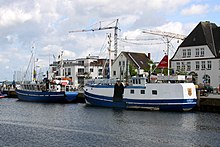

In Eckernförde there are four harbors as well as a landing stage at the torpedo shooting facility in the south (Sandkrug) of the city.
- The Eckernförde city harbor - usually just referred to as a harbor - serves, among other things, as a fishing and traditional sailing harbor . In previous years, freight, mainly grain, was also handled here. Until the end of the 1990s, the port was connected to the rail network with a port railway . The Eckernförde gauge is at the wooden bridge .
- The outer harbor is located at the entrance to the harbor - a marina mainly for motor and sailing yachts.
- The Kranzfelder Hafen in the Louisenberg district , named after Alfred Kranzfelder , is a deep-sea port of the German Navy , in which all German submarines are now stationed.
- The SC Eckernförde marina is located on the border between Louisenberg and Borby .
The grass snake - a buoy - borders in the Bay of Eckernförde the entire range of Eckernförder ports including the roads from -Seeflächen. Even in the 1980s, it was enough to go around the grass snake on a passenger ship or fishing cutter for duty-free shopping.
media
The daily newspapers Eckernförde Zeitung and Kieler Nachrichten appear in Eckernförde (with the regional edition Eckernförder Nachrichten ). The same name ( Eckernförder Nachrichten ) also had a liberal newspaper published twice a week by the Reichstag deputy Wilhelm Spethmann at the beginning of the 20th century . The yearbook of the home community Eckernförde appears annually , which deals with both historical and current affairs from the area of the former Eckernförde district.
Public facilities
- District court Eckernförde
- Danish library (in the Jes Kruse-Skole )
- Tax office Eckernförde-Schleswig
- Vehicle registration office for the Rendsburg-Eckernförde district
- Imland Klinik Eckernförde (previously Eckernförde District Hospital )
- Museum Eckernförde in the old town hall since 1987
- City hall with city library
- Sea water wave pool
- Baltic Sea Info Center (Aquarium)
- the “house” with a communal cinema
- Consulate of the Republic of Niger
Private institutions
- Gallery “nemo” for contemporary art with a copper printing workshop
- Fish smokehouse museum Alte Fischräucherei Eckernförde
education
General education schools
Student numbers from the school year 2019/2020
-
Funding Centers (FöZ)
- Pestalozzi School (FöZ learning), Reeperbahn, 97 students in 12 classes (93 supervised)
- Schule am Noor (FöZ Intellectual Development), Stolbergring, 107 students in 12 classes (4 supervised)
- Sternschule (FöZ language), Wulfsteert
-
Primary schools (GS)
- Richard Vosgerau School, Bergstrasse, 145 students in 7 classes
- Fritz Reuter School, Breslauer Straße, 178 students in 8 classes
- Sprottenschule (since 2017, amalgamation of the ex Gorch-Fock and GS part of the ex Albert-Schweitzer-Schule), Wulfsteert, 320 students in 15 classes
-
Community schools (GemS)
- Gudewerdt Community School, horse market, 632 students in 28 classes (name since 2017, ex Albert Schweitzer School without GS part)
- Peter-Ustinov-Schule Eckernförde (GemS with upper secondary school), Sauerstrasse, 888 students in 38 classes
- Jes-Kruse-Skolen (GS, GemS, FöZ), Hans-Christian-Andersen-Weg, 333 students in 17 classes
-
high school
- Jungmann School , Sauerstraße, 772 students in 31 classes
-
Free schools
- Free Waldorf School, Schleswiger Straße, 423 students in 19 classes
Vocational schools
- Vocational Training Center (BBZ) Rendsburg-Eckernförde, Eckernförde location, Fischerkoppel
Former institutions
- Willers-Jessen-Schule, Kieler Straße (until 2013)
- Sandkrugschule , Berliner Straße (until 1968)
- Gorch Fock School , Sauerstraße (until 2017)
- The construction department of the Kiel University of Applied Sciences , which emerged from the Eckernförde Building School , most recently at Lorenz-von-Stein-Ring, was closed by a decision of the state government in September 2007 and added to the Lübeck University of Applied Sciences . The construction school was partially demolished in 2014–2015 in order to create a new residential complex there. The listed main building was preserved.
- Teachers' seminar in Eckernförde , Bergstrasse (until 1924)
- Eckernförde fishing school, Sehestedter Straße
- Agricultural school, Stolbergring
- State Fire Brigade School Schleswig-Holstein and State Police School Schleswig-Holstein (temporarily after World War II) in Carlshöhe
- Central Office for Regional Studies ( Schleswig-Holsteinischer Heimatbund ), Mühlenberg
Other educational institutions
- Volkshochschule Eckernförde, Reeperbahn
- Home community Eckernförde , Carlshöhe
Personalities
City personalities
Honorary citizen
- Jürgen Anbuhl (* 1940), long-time mayor of the city, former member of the Bundestag for the constituency of Eckernförde, former headmaster
- Wilhelm Lehmann (1882–1968), teacher and writer
- Kurt Schulz (1922–2017), former mayor of the city of Eckernförde, long-standing member of the state parliament for the constituency of Eckernförde and former state representative for the border region, minorities and the Low German language
Others
Eckernförde has been a “UN City” since May 14, 1986. In 1994/1995 Eckernförde was the “Federal Capital for Nature and Environmental Protection”. The title of “Environmentally Friendly Community” was achieved in 1988, 1992, 1996 and 2000. In 2006 Eckernförde won bronze in the national competition Our city is blooming .
There is an entry in the church records of the Church of Saint Nicholas about the death of the Count of Saint Germain . The grave is said to have been destroyed by the storm surge in 1872.
The telecommunications tower is 63 meters overall height the tallest structure in Eckernförde.
The European long-distance hiking trail E6 leads through Eckernförde. In addition, the nature park path , which connects the five nature parks in Schleswig-Holstein for hikers, begins here .
The Marine Special Forces command and the German Navy Sea Battalion are stationed in Eckernförde. A military technical department of the Bundeswehr for ships and naval weapons is located in Eckernförde.
The German Life Saving Society Schleswig-Holstein moved its headquarters from Kiel to Eckernförde in the early 1960s. Between 1960 and 1963, the DLRG built its regional center below the “big” lighthouse. This was expanded from 1985 to 1987 and received another extension in 2008/2009. Eckernförde is the seat of the regional office. In addition, almost all relevant specialist training and further education for water rescuers take place in Eckernförde.
The fishing license plate of the fishing trawler with home port Eckernförde is "ECKE".
The earlier license plate number (until April 25, 1970) for the Eckernförde district was ECK; Since November 15, 2012, it can again be issued as a license plate for the Rendsburg-Eckernförde district .
The following were named after the city of Eckernförde: the Eckernförde Bay , the Eckernförde Lobus (part of the Baltic Sea Glacier), the Eckernförde (the temporary name of the Gefion from 1843), Eckernförde - a rescue boat, C-Eckernförde - a tribe of the mouth disease , the former county Eckernförde , the former Eckernförder Harde , former Eckernförder Kanalgutsbezirk in Holtenau, the battle of Eckernförde , the Eckernförder sculpture school of Gudewerdt family Eckernförder faience , the fictitious last name Eckernförde in the film Erkan & Stefan , Eckernförde - a song of the band Truck Stop , the Eckernforde Tanga University Institute of Health Sciences , a private university in the twin town Tanga in Tanzania.
Ships
- Svanen , a sailing ship built in Eckernförde in 1777/78, which was Iceland's connection to Europe in the 18th and 19th centuries
- SMS Gefion (1843) , at times SMS Eckernförde , Danish, later Prussian sailing frigate
- Planet (ship, 2005)
- Mine diving boat Mühlhausen (M 1052)
- Alster (class 423) , Oste, Oker fleet service boat
- Diving school boat Langeoog
- Sea rescue boat Eckernförde (ship)
- Roald Amundsen (ship) , a brig from 1952
- Eckernförde volunteer fire brigade , oil rescue boat 2001 (state equipment), this was handed over to the Rendsburg volunteer fire brigade in spring 2012, now sails there under the name "Florian"
The Kranzfelder Hafen ( 1st submarine squadron ) is the home port of several war and research ships and the home port of the currently six submarines of the German Navy ( U 31 to U 36 )
literature
- Uwe Beitz: Eckernförde and the Baltic Sea. Sutton Verlag, Erfurt 2004, ISBN 3-89702-694-5 .
- Karl Friedrich Schinkel: Eckernförde - a walk through the city's history. 3. Edition. Rolf Stuhr, Haan 2009 ( reading samples ( memento from April 6, 2011 in the Internet Archive ))
- Heinz-Herbert Schöning: The Eckernförde district railways. Kenning, Nordhorn 1998, ISBN 3-927587-70-2 .
- Horst Slevogt: Eckernförde - The history of a German merchant town in the Duchy of Schleswig . Volume 1: From the beginnings to the Reformation. Husum Verlag, Husum 1997, ISBN 3-88042-820-4 . Volume 2: From Gottorfischer to Danish to Prussian rule. Husum Verlag, Husum 2006, ISBN 3-89876-183-5 .
- Heinz Teufel , Christoph Rohde: Eckernförde - portrait of the Baltic city. Medien-Verlag Schubert, Hamburg 1994, ISBN 3-929229-21-8 .
- Jann M. Witt (Ed.): Eckernförde. History of a port and marine city . Convent, Hamburg 2006, ISBN 3-934613-96-9 .
- Home community Eckernförde: ECKernförde-Lexikon . Husum, North Sea 2014, ISBN 978-3-89876-735-4 .
- Harald Jørgensen, OM Olesen, Frants Thygesen (Red.): Egernførde bys historie. Studieafdelingen ved Dansk Centralbibliotek for Sydslesvig, Flensburg 1980, ISBN 87-980393-5-0 (Danish)
Web links
- Official website of the city
- History from Eckernförde by Stefan Deiters
- History to watch. Archived from the original on September 24, 2002 ; accessed on October 21, 2015 .
- Link catalog on Eckernförde at curlie.org (formerly DMOZ )
Individual evidence
- ↑ North Statistics Office - Population of the municipalities in Schleswig-Holstein 4th quarter 2019 (XLSX file) (update based on the 2011 census) ( help on this ).
- ↑ Maria Bojesen: Rejse igennem Danmark , Volume 1, Kjøbenhavn 1856, page 824
- ^ Carl Ferdinand Allen: Om sprog og folke-eiendommelighed i hertugdømmet Slesvig eller Sønderjylland , Kjøbenhavn 1848, page 71
- ↑ Johannes Kok: Det danske folkesprog i Sønderjylland , Volume 2, Copenhagen 1867, p. 177
- ↑ Wolfgang Laur: Historisches Ortnamelexikon von Schleswig-Holstein , Neumünster 1992, p. 225
- ↑ Topographic map "Hütten" (measuring sheet map), Royal Prussian land survey 1877 with supplements 1904.
- ↑ Listed places of today's Eckernförde city and districts in: Address book and business manual for the city and district of Eckernförde. (Directory of places). Verlag von C. Heldt's Buchhandlung, 1897, pp. 95 ff.
- ↑ City of Eckernförde, development plan 2012.
- ^ Federal Statistical Office (ed.): Historical municipality directory for the Federal Republic of Germany. Name, border and key number changes in municipalities, counties and administrative districts from May 27, 1970 to December 31, 1982 . W. Kohlhammer, Stuttgart / Mainz 1983, ISBN 3-17-003263-1 , p. 184 .
- ^ Manfred Niemeyer: German book of place names . De Gruyter, Berlin 2012, ISBN 978-3-11-025802-8 , pp. 146 .
- ↑ Æckernførde , Æckelnførde with Nicolay Jonge: Kongeriget Danmarks chrorografiske Beskrivelse , Copenhagen 1777, p. 927
- ↑ Hekelsuorrde , map of Schleswig-Holstein by Giovanni Francesco Camocio, 1588
- ↑ The information about the start of construction vary, e.g. B. Start of construction between 1150 and 1180 according to the parish of Borby (online) , construction of the Borby church according to Karl Friedrich Schinkel from 1185 to 1190 - in KF Schinkel: Eckernförde - a walk through the town's history. 2nd Edition. Manfred Goos, Horn-Bad Meinberg 2002, p. 154.
- ↑ Peter Friedrich Andersen: The newest Anabaptist movements in Denmark . In: Dr. Christian Wilhelm Niedner (ed.): Journal for historical theology . TO Weigel, Leipzig 1845, p. 147 .
- ^ Uta Schäfer-Richter, Jörg Klein: The Jewish citizens in the Göttingen district - a memorial book. Wallstein Verlag, Göttingen 1992, p. 124.
- ^ Dieter Pust: Flensburg street names . Society for Flensburg City History, Flensburg 2005, ISBN, article: Asmus-Jepsen-Weg
- ^ Schleswig-Holstein community of voters, including a German party (DP) and community of the war generation (GKG), later operating together with the BHE as the German election community (DWG)
- ↑ Figures for the Eckernförde council assembly election on May 6, 2018 according to Eckernförder Zeitung of May 7, 2018, pages 1 and 7
- ↑ Schleswig-Holstein's municipal coat of arms
- ↑ Entry about the twin town Macclesfield on the homepage of the town of Eckernförde.Retrieved on March 30, 2019, 12:17 pm
- ^ In: Heinrich Rantzau (1526–1598) governor in Schleswig and Holstein. A humanist describes his country. Catalog of an exhibition of the Schleswig-Holstein State Archives 1999, p. 255, Latin original text p. 132.
- ↑ Cf. Danish-language city maps of Eckernfördes, such as that by CF Woisolofsky from 1768.
- ↑ Kiel News. January 9, 2008.
- ↑ a b The monument to the Great Elector in Eckernförde. on: ostpreussen-info.de
- ↑ The Great Elector as a symbol for the old homeland. In: Eckernförder Zeitung. August 6, 2013.
- ↑ All about sport Eckernförde. 6th edition. 2010 (sports club directory of the city administration)
- ↑ Federal Employment Agency: Rendsburg-Eckernförde. Retrieved September 22, 2015 .
- ↑ Rooms and equipment on the youth hostel website
- ↑ Rooms and equipment DLRG guest house website
- ^ Friedrich Wilhelm von Reden: The railways of Germany . Ernst Siegfried Mittler, Berlin / Posen / Bromberg 1846, p. 146 ( limited preview in Google Book search).
- ^ Friedrich Wilhelm von Reden: German Railway Book: a paperback for travelers, stockholders, railway officials, innkeepers, merchants and businessmen of all kinds . Adolf Gumprecht, Berlin 1845, p. XXV ( limited preview in Google Book Search).
- ↑ route map. (PDF) kiel.de, archived from the original ; accessed on May 18, 2017 .
- ↑ Route network. (PDF) Retrieved May 18, 2017 .
- ↑ Kiel: "The Stadtregionalbahn is dead as a mouse". In: Schleswig-Holstein newspaper publisher . December 16, 2014, accessed March 13, 2015 .
- ↑ Eckernförder Zeitung from September 13, 2018
- ↑ translator2: EuroVelo 10 - EuroVelo. Retrieved May 5, 2017 .
- ↑ Statistical Office for Hamburg and Schleswig-Holstein: Directory of general education schools in Schleswig-Holstein 2019/2020
Remarks
- ↑ According to individual sources, e.g. B. labs.familysearch.org seems to have given the place name slaughterhouse for this area ; Until the second half of the 1960s, the slaughterhouse itself stood where the seawater wave pool is today.
- ↑ Shown in: Karl Friedrich Schinkel: Eckernförde - a walk through the city's history. 2nd Edition. Manfred Goos, Horn-Bad Meinberg 2002, p. 418.
- ↑ Today built with the Gudewerdt-Sporthalle II, the EMTV-Heim, the allotment garden club house and the environmental information center
- ↑ A CDU council member switched to the free electorate during the 2008-2013 election period .
- ↑ Community of the war generation within the Schleswig-Holstein community of voters (SHWG)
- ↑ Schaper had designed a marble sculpture of the Great Elector on behalf of Wilhelm II , which was erected in 1901 in Siegesallee in Berlin. In 1913 the emperor granted the port city of Pillau a bronze cast. Schaper probably also made the cast for the Sparrenburg , which was erected in 1900, based on his model .
- ↑ Baltic Sea Cycle Route - Baltic Sea Schleswig Holstein. Retrieved May 5, 2017 .
- ↑ See Ólafsvík


